Byssus is an extremely fine, rare, and valuable fabric of animal origin. It is a sort of natural silk with golden and sparkling reflections that is obtained from the filaments secreted by a large marine bivalve mollusk known as a “noble pen shell” or “fan mussel” – Pinna nobilis. Its processing has been developed exclusively in the Mediterranean area since ancient times.
Pinna nobilis is an endemic species of the Mediterranean and is the largest bivalve present in that sea; the shell is usually 30–50 cm (0.98–1.6 ft.) long, but it can reach 120 cm (3.93 ft). It lives about 20 years and theoretically, like other mollusks, is also edible. In the past it was also used for its marked therapeutic and hemostatic properties, to obtain nacre (mother of pearl) from its valves, and the shell has been used to make objects for domestic use. But more than anything else, it has been valued for the precious byssus – one of the most valuable goods since time immemorial.
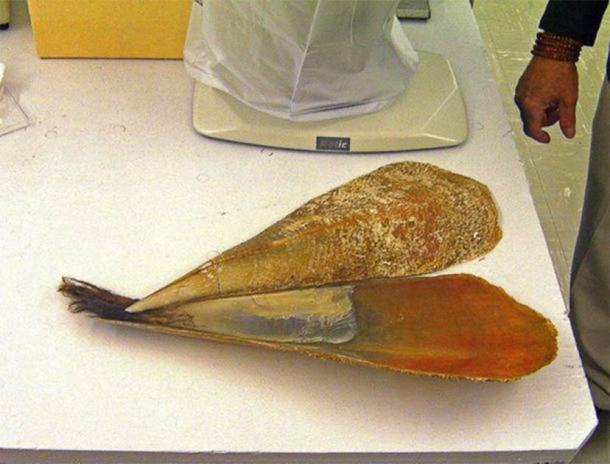
Pinna nobilis shell and byssus or sea silk. ( CC BY-SA 3.0 )
From a naturalistic point of view, P. nobilis was well known by the ancients. Many authors, first of all Pliny and Aelian, described it, attributing it with great predatory abilities and a certain intelligence.
What is Byssus?
The filaments produced by the shell – a sort of burr – are keratin (the same substance as hair and nails). They solidify in contact with water and produce a brownish scale encrusted with shells, algae, and small corals that, once worked and bleached, becomes a golden, soft, and resistant thread.
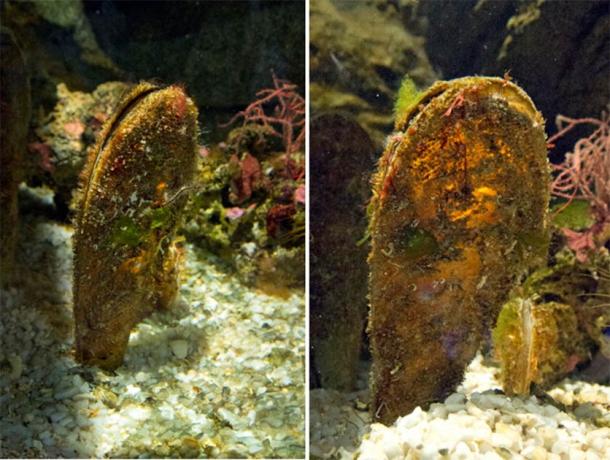
P. nobilis. Courtesy of Massimo Piacentino.
It is difficult to accurately establish and locate the origin of the production of these fine fibers because the term byssus that appears in the ancient literary sources (from the Greek ἡ βύσσος, literally “fine linen”), can refer both to the product of P. nobilis and to a very fine fabric of vegetable origin, perhaps a superior quality of linen or even cotton, probably from Linum asbestinum or Gossypium arboreum, commonly called tree cotton.
Homer himself talks about it, even if in his works the specific term is never used, but some expressions -“shining like a star” and “tunic … shining on the body, like a dry onion skin, it was so soft, like a bright sun ” – make the reference to byssus very plausible.
The corpse of Anchises, Aeneas’s father, was wrapped in bands of byssus and Herodotus (5th cent. BC) reports that Egyptians used to wrap corpses with “bandages cut from byssus cloth and coated with rubber” and that “very fine bandages of byssus” were also used to bandage the wounds sustained in battle.
Perhaps the sea silk byssus was too precious even for such noble uses, therefore, in these cases the term could refer to a superior quality of linen or cotton, as suggested by some scholars.
Ancient References Attesting to the Value of Byssus
The term byssus also appears in the Old Testament. For example, in Exodus the Lord orders Moses to provide a “cloth of purple and red, scarlet byssus” as an offering and the veils of the tabernacle and the clothes of the priests were made “of fine byssus […] embroidered with figures of cherubs.”
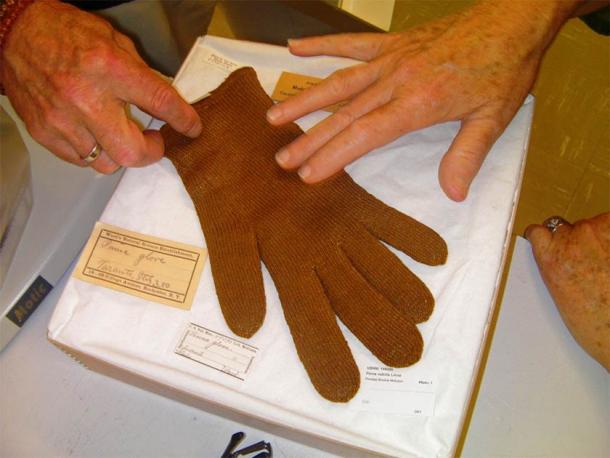
Knitted sea-silk glove from Taranto, Italy. Probably late 1800s. (John Hill, CC BY-SA 3.0 )
In the second book of Chronicles, the king of Tyre, Chiram, sends Solomon a craftsman who is an expert in “purple, violet byssus and crimson yarns.” At the behest of Solomon, the curtain of the temple and the garments of the Levite singers had to be made with byssus.
Theocritus (4th/3rd cent. BC) talks about it in his second Idyll and according to the legend, Cleopatra herself was dressed in byssus on the day of the Battle of Actium (31 BC). Probably she was wearing a dress similar to the Tarantinids, the diaphanous, soft, light, golden-colored feminine dress typical of Taranto (a coastal city in Apulia, Southern Italy), sought after and worn by matrons, famous hetairai (a type of prostitute in ancient Greece), dancers, and bacchantes.
Chrysippus of Soli (3rd cent. BC), Pamphilus of Alexandria (1st cent. BC/1st cent. AD) and Athenaeus of Naucratis (2nd/3rd cent. AD) report fabrics most likely made with this fiber, but the oldest document where the product of P. nobilis is precisely mentioned is perhaps the Periplus maris erythraei (“Periplus of the Erythraean Sea”, 1st cent. AD), where the term πινικόν is specifically used.
The first Greek author who testifies to the processing of textile materials from Pinna is the sophist Alciphron (perhaps 2nd cent. AD): in a letter dedicated to fishermen. He describes them as a sea wool “which grows so freely in the meadows of Eurynome” – that is in the water meadows and pastures.
On the other hand, Tertullian’s description (3rd century AD) regarding the different materials used for weaving is unequivocal: “As if it were not enough to plant and cultivate tunics, it even happens that garments can be fished. In fact, quite soft fluff flakes are also obtained from the sea, which form the crown of certain mossy shells.”
Equally unequivocal are the words of Basil the Great (4th cent. AD, “byssus lifting a golden fleece that so far none of the dyers has been able to imitate”) and of the Byzantine historian Procopius (6th cent. AD) who, speaking about the official insignia sent by the Roman Emperor to the five hereditary satraps ruling Armenia, mentions a “cloak made of wool, not such as is produced by sheep, but gathered from the sea. Πίννους the creature is called on which this wool grows”, worthy to be described “for they will never again be seen by man.”
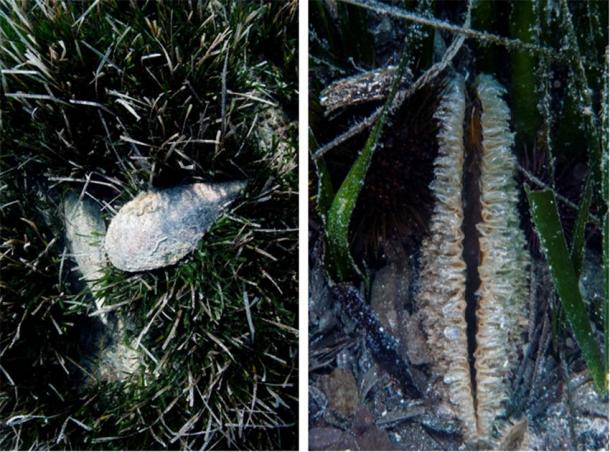
Pinna nobilis shell and byssus or sea silk. (Images Courtesy of Stefano d’Urso)
The Oldest Byssus Artifact
The oldest byssus artifact of P. nobilis found so far precisely dates back to these times. It was a female funerary outfit discovered in 1912 in Aquincum (now Budapest), but it was unfortunately destroyed by bombing during the Second World War.
In Rome byssus was considered so valuable that it was sold for gold, as confirmed by the edict of Diocletian. It mainly came from Egypt, Scythopolis near Damascus in Syria, from Tarsus in Cilicia, and from Apulia and Sardinia in Italy, but not in large quantities.
Once collected, (the shell was extracted from the seabed with ropes or special tools), the fibers had to be washed several times – originally in bovine urea, which was later replaced by lemon juice – to eliminate the salinity and make them more elastic and bright. Then they had to be dried in the shade and combed several times. Finally, they were spun and colored.
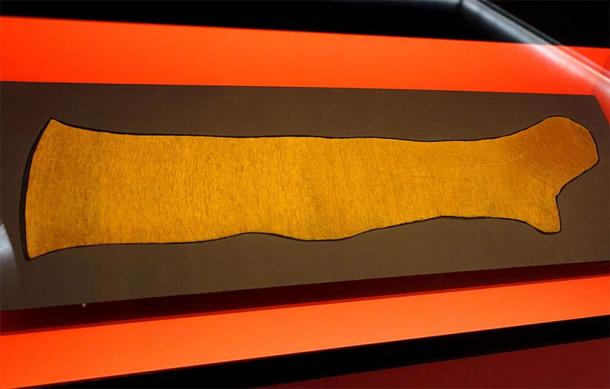
Stocking made of sea silk (byssus) from Pinna nobilis, 1765-1800 AD, in the Naturhistorisches Museum, Braunschweig, Germany. (Daderot / CC0)
According to the ancient Phoenician technique (they transported byssus from Syria), the most precious dye used was purpura, the Tyrian purple (also known as Phoenician red), a reddish natural dye produced by several species of predatory sea snails originally known by the name Murex. In ancient times, extracting this dye involved tens of thousands of snails and substantial labor, and as a result, the dye was highly valued.
The Niche Production of Sea Silk
The decline of byssus yarns began as early as the time of Emperor Justinian (500 AD), when mulberry moss, better known as silkworm, was introduced to Europe.
In a short time the production of silk spread throughout the Italian peninsula and the empire, to the point of almost supplanting byssus, which involved much higher costs and required more refined techniques.
Thus, the spinning of byssus remained only a local tradition in small individual production centers, especially in Italy (Puglia, Calabria, Sicily, Sardinia), France (Corsica), Greece, and Turkey. They mainly produced garments to wear under armor, to reduce weight and heat (like linen under the famous iron crown of Charlemagne), or small items such as gloves, socks, caps, etc.
Today, the oldest byssus object is a precious knitted cap, found in 1978 during an archaeological excavation at the basilica of Saint Denis in Paris. It is now exhibited at the Natural History Museum in Basel. Stratigraphic dating places its creation to the 14th century.
For such luxury items, byssus production resumed to some extent in the 18th and 19th centuries, especially in southern France and southern Italy. But towards the end of the 19th century the textile use of byssus was completely abandoned.
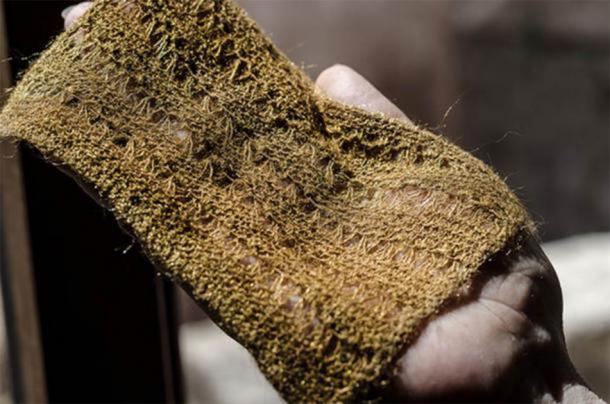
Material produced from sea silk by Chiara Vigo, last master of sea silk manufacture. ( CC BY-SA 2.0 )
The culinary use of Pinna nobilis also became very limited because people learned that it is extremely risky to consume it – filter mollusks accumulate large quantities of pollutants and pathogens.
For some time its use for therapeutic purposes continued. The shell was dipped in hot oil and used to treat earaches and sometimes even deafness. Fishermen also kept using it as a hemostatic if they were injured while fishing.
The Last Sea Silk Master
In 1992 P. nobilis was listed as an endangered species in the Mediterranean Sea. The European Council Habitats Directive 92/43/EEC, on conservation of natural habitats and the wild fauna and flora, proclaims that P. nobilis is strictly protected (by the Annex IV of EEC, 1992) and all forms of deliberate disturbance, capture, or killing of fan mussel specimens are prohibited by law.
What remains today of this traditional weaving is a very small workshop of byssus processing in Sardinia/Italy. Currently it is active for purely illustrative and informative purposes. Here, in Sant’Antioco, the last teacher of this ancient art, Master Chiara Vigo , lives, works, and teaches. Byssus’s significance in history remains thanks to her.
Top image: Byssus filaments. Source: Stefano d’Urso / Alessandro Andreotti
References
Aelian On the Nature of Animals III, 29.
Alciphron, Letters, Letters from the country to the fishermen I, 2, 3.
Alfaro Giner C., Karali L. eds., Vestidos, textiles y tintes: estudios sobre la producción de bienes de consumo en la Antigüedad, in Actas del II Symposium Internacional sobre Textiles y Tintes del Mediterráneo en el mundo antiguo (Athens, 24 – 26 November, 2005.)
Basil of Caesarea , Homilies on Six Days of Creation, VIII.
Book of Chronicles , II 1, 3, 4, 12-14.
Book of Exodus XXV 4; XXVI 1, 31, 35; XXVII 9, 17, 18; XXVIII 5, 6, 9, 15, 39; XXXV 6, 23, 25, 35; XXXVI 8, 35, 37; XXXVIII 9, 16, 18, 22; XXXI, 1-5, 8, 24, 27, 29.
Book of Revelation X VIII 11-13; 15-17.
Cassius Dio, Roman History LXV 15.
Giannettasio Nicolò Partenio Halieutca. III 15.
Herodotus II 86; VII 181, 182.
Homer, Iliad VI 369-372; Odyssey XV 104-108; XIX 232-234.
Małgorzata Biniecka ed., The Masters of Byssus, Silk and Linen , Collana Materiali e documenti 15, Sapienza Università Editrice 2017.
Maeder F. Hanggi A. Wunderlin D. eds., Bisso marino. Fili d’oro dal fondo del mare. Catalogo della Mostra, Basel, 19 marzo – 27 giugno 2004.
Pliny the Elder, Natural History I, 142; XXXII 154.
Periplus of the Erythraean Sea XXI, 2; XXXIV, 4, XXXV, 7; XXXVI, 6.
Procopius of Caesarea, The Buildings , III, 1, 19-20.
Sada L., Perle dei mari di Puglia , Schena Editore 1983.
Solito D., Cenno storico della origine, del progresso, e decadimento dell’antichissima città di Taranto e Breve descrizione della conchiglia pinna e del modo come da questa si ricava la lana marina , Tipografia di Crispino Puccinelli, 1843.
Suetonius, Titus VIII, 2.
Tertullian, On the Ascetic Mantle III, 6.
Ventura G., L’ostrica e la pinna: storia, leggenda e curiosità , in Atti del Convegno 13-14 maggio 2009, Roma.
Related posts:
Views: 0
 RSS Feed
RSS Feed

















 January 6th, 2021
January 6th, 2021  Awake Goy
Awake Goy  Posted in
Posted in  Tags:
Tags: 
















